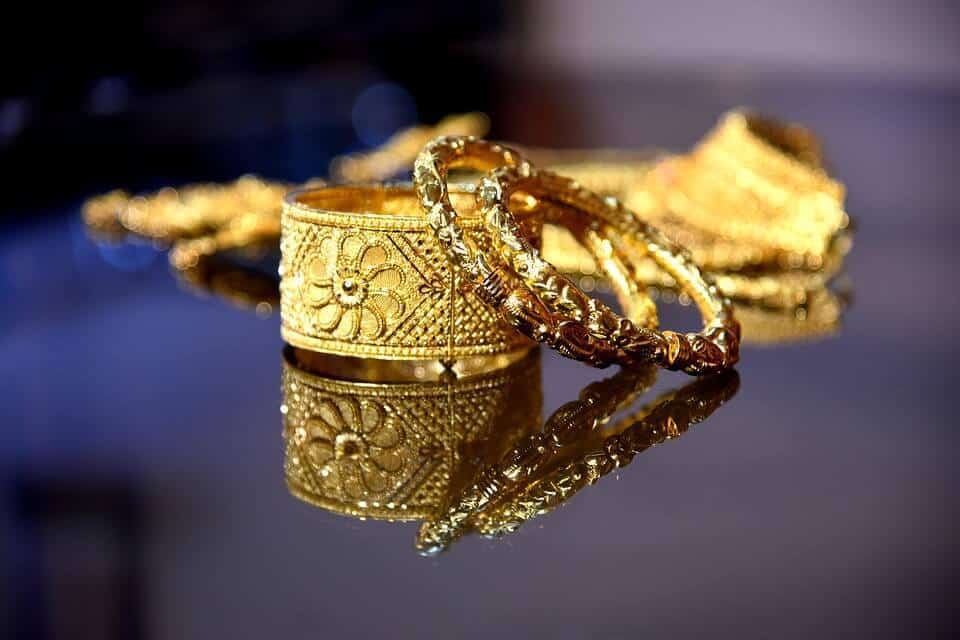
Table of Contents
Hallmarks on jewelry are important because they provide information about the metal type and also indicate that the metal is likely authentic. 925 is a hallmark found on silver jewelry, and is commonly used to signify sterling silver. But sometimes, you’ll see it also printed on gold jewelry. This is a cause of confusion for many people and can even lead to you getting ripped off. Let’s clarify what 925 printed on gold really means.
1. 925 is Sterling Silver

If your piece has .925 (also written as 925.) stamped on it, this means that it is a silver alloy. Because pure silver is too soft to be used by itself in the making of jewelry, it is often mixed with other metals to create a more durable and lustrous alloy. 925 means that the metal is 92.5% silver and 7.5% other metals (often copper and nickel).
Genuine sterling silver should have the 925 hallmark printed somewhere on the piece of jewelry, often on the clasp or on a hidden part of the piece. Most retailers will mention in the product description that the piece has been stamped with the 925 hallmark. If not, always double check with them.
2. What Is 925 Gold?

Sometimes you’ll see gold jewelry stamped with this hallmark. This simply means that the piece of jewelry is silver that’s been plated in gold. It’s not solid gold. The hallmark is stating the purity of the underlying metal and not of the plating itself. This type of metal is known as gold vermeil and is commonly used for beautiful costume jewelry.
Some people will tell you that 925 on gold means that the item is made of 925/1000 parts gold or, to put it another way, is 92.5% gold. This is not true and is a misleading statement.
925 is not an accepted value for gold purity and has no connection to any common karat numbers used for denoting gold purity.
Gold is commonly classified according to karatage, with the most popular karat numbers being 18K, 14K, 12K, 10K and 9K. This states the amount of gold purity in each piece, with 24 being the maximum number of karats.
So, this means:
- 24K gold = 999
- 22K gold = 917 or 91.7%
- 18K gold = 750 or 75%
- 14K gold = 585 or 58%
- 10K gold = 417 or 41.7%
- 9K gold = 397 or 39.7%
As you can see, there’s no 925 gold on this list.
3. So What is 925 Purity?
925 would be 16.65 K gold, which is not a common purity value for gold. The closest purity grade to ‘925’ gold would be 22 karats which is 917 or 91.7%.
Gold plated sterling silver jewelry is difficult to tell apart from solid gold. Unscrupulous retailers may try to dupe you into thinking that 925 gold is solid gold, because silver is much more affordable than gold and it is in their interest to do this. But don’t be fooled. You can check for the hallmark or have the piece acid tested by a professional jeweler to check the gold purity level of the metal.
4. Variations to 925

Sometimes you’ll see STER, STERLING, STG or Sterling Silver on the piece of jewelry. This all means the same thing – that the piece is 925 silver.
You may also see the stamp 925 EP. This indicates sterling silver with a thin coating of gold electro plated onto it. In other words, it is a hallmark for gold vermeil.
If your gold piece has 925 Italy on it, it just means that the item is silver that’s been plated with gold and made in Italy.
Should I Buy 925 Gold?
There’s nothing wrong with buying a piece of gold jewelry that has been stamped 925 as long as you know that it is indeed gold vermeil. If in doubt, check with the retailer. They should be able to disclose this information to you.
Check out Amazon’s stunning collection for a wide range of beautiful gold vermeil and silver jewelry. Make sure you check the authenticity of the piece with the retailer if you aren’t sure. We also recommend searching on Etsy’s impressive collection of artisan, vintage, and modern 925 jewelry designs.









